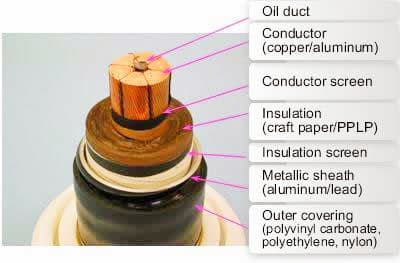
In the realm of high-voltage power transmission, oil filled cable have emerged as crucial components, offering unique advantages in terms of efficiency, reliability, and safety. These cables are designed to withstand high electrical stress while maintaining operational integrity over long distances. This article explores the technology behind oil-filled cables, their applications, advantages, and future prospects in the energy sector.
What are Oil Filled Cable?
Oil filled cables, also known as oil impregnated paper (OIP) cables, are a type of high-voltage power cable where the conductor is surrounded by oil-impregnated paper insulation. The oil serves multiple critical purposes within the cable structure:
- Insulation: The primary function of the oil is to insulate the conductor from the surrounding environment and other conductive elements. Oil has excellent dielectric properties, which means it can withstand high electric fields without breakdown.
- Cooling: Oil acts as a coolant, dissipating the heat generated during operation. This feature is particularly crucial in high-voltage applications where heat buildup can degrade the cable’s performance.
- Mechanical Support: The oil-impregnated paper provides mechanical support to the conductor, preventing deformation and maintaining the cable’s structural integrity.
Applications of 132kV Oil Filled Cable
Oil filled cable are predominantly used in high-voltage transmission and distribution networks where reliability and efficiency are paramount. Some specific applications include:
- 132kV Transmission Lines: Oil filled cable are widely employed in 132kV and higher voltage transmission lines due to their ability to efficiently carry large amounts of electrical power over long distances.
- Submarine Cables: In underwater or submarine applications, oil filled cables are preferred because the oil insulation provides additional protection against water ingress and corrosion.
- High-Voltage Direct Current (HVDC) Systems: HVDC systems require cables that can handle high voltages and currents with minimal losses. Oil filled cables meet these requirements and are used in interconnectors between power grids and in long-distance transmission.
Oil Filled Cable advantages
- High Insulation Strength: Oil has superior dielectric properties compared to air or solid insulation materials, allowing oil filled cables to withstand high electric stress levels without breakdown.
- Excellent Cooling Properties: The oil dissipates heat effectively, preventing hotspots and ensuring the cable operates within safe temperature limits.
- Long Operational Life: Properly designed and maintained oil filled cables can have a service life of several decades, making them a reliable choice for long-term power transmission infrastructure.
- Resistance to Environmental Factors: The oil insulation protects the cable from moisture, pollutants, and other environmental factors, extending its operational reliability.
- Reduced Capacitance: Oil filled cables typically have lower capacitance compared to other types of cables, which reduces charging currents and improves overall efficiency.
Oil filled electric cable challenges and considerations
While oil filled cables offer significant advantages, they also come with some challenges:
- Maintenance: Regular maintenance, including oil sampling and testing, is essential to monitor the condition of the insulation and ensure continued reliability.
- Environmental Impact: The use of oil raises environmental concerns, particularly in case of leaks or spills. Modern designs use environmentally friendly insulating oils to mitigate these risks.
- Cost: Initial installation costs of oil filled cables can be higher than alternatives due to the complexity of manufacturing and installation.
Oil filled high voltage cable
Advancements in materials science and manufacturing techniques continue to improve the performance and efficiency of oil filled cables. Future trends include:
- Nanotechnology: Incorporating nanomaterials into oil insulation to enhance dielectric properties and reduce size and weight.
- Smart Monitoring: Integration of sensors and IoT technology for real-time monitoring of cable health and performance.
- Environmental Sustainability: Development of biodegradable or less toxic insulating oils to minimize environmental impact.
Oil Filled Cable Manufacturer
We,Dosense Cable, Oil filled cable represent a robust solution for high-voltage power transmission, offering unparalleled reliability, efficiency, and longevity. Despite challenges related to maintenance and environmental impact, ongoing technological advancements promise to enhance their performance and sustainability in the future. As the global demand for reliable electricity transmission grows, oil filled cables are expected to play a crucial role in meeting these challenges effectively and efficiently.
